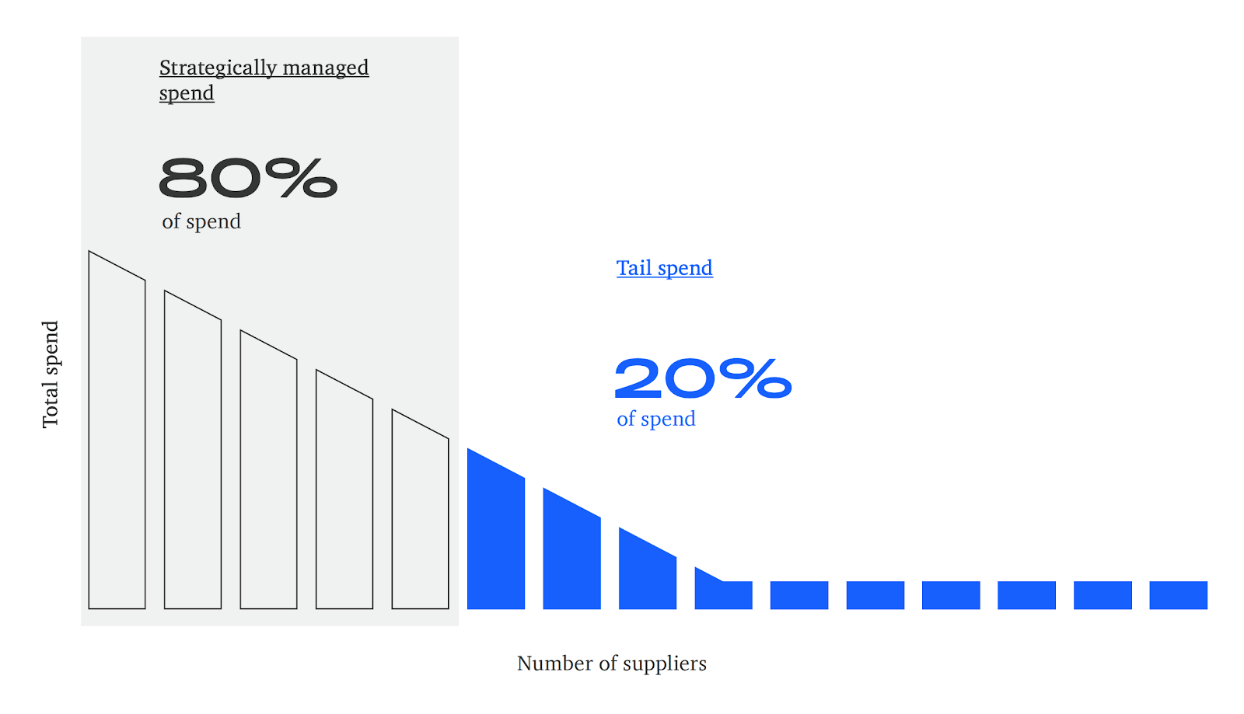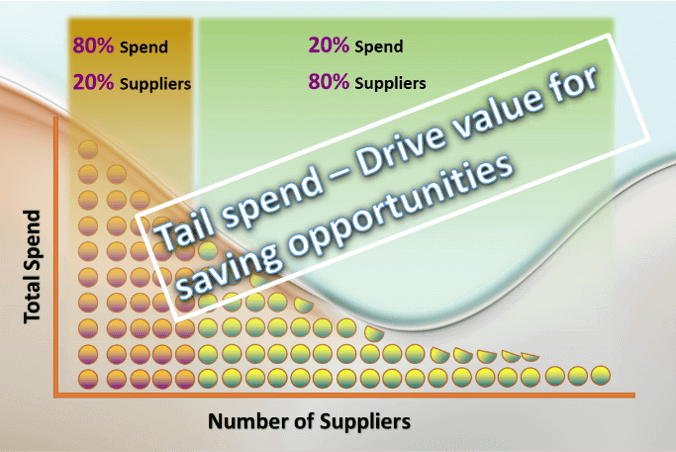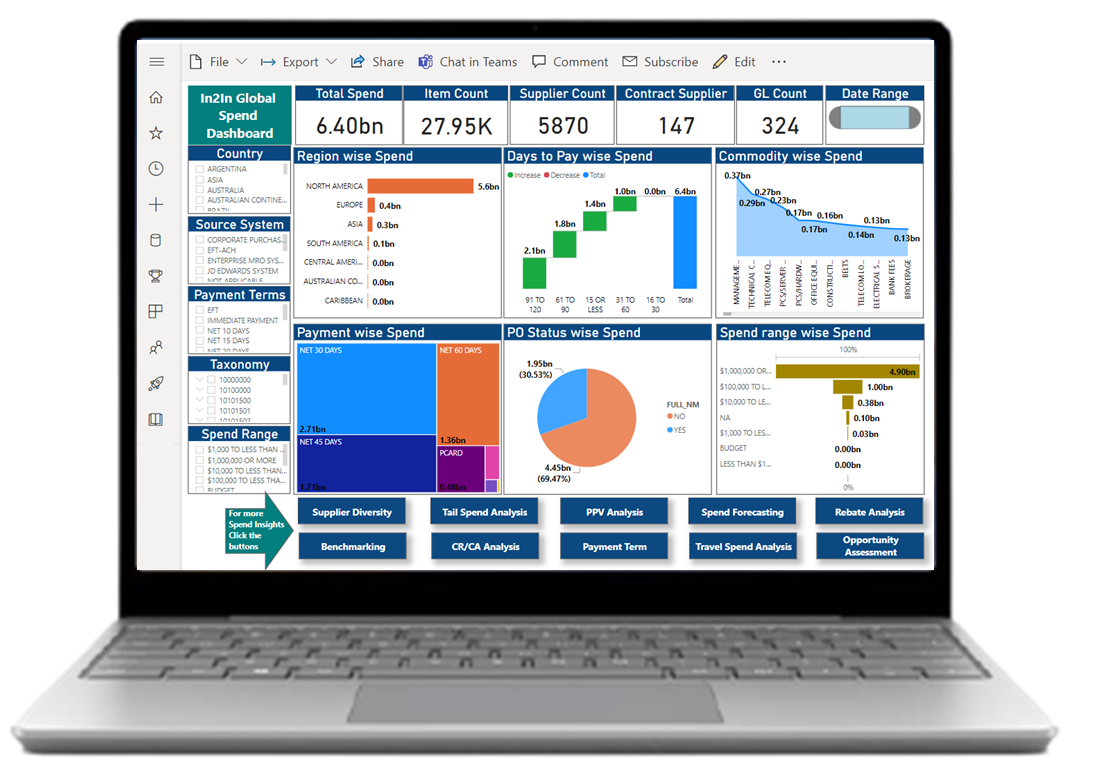Tail spend – Drive value for saving opportunities
Tail spend is a notion that is commonly used in procurement departments but rarely optimised. It is finally receiving its due. A procurement department can become a major competitive advantage for a firm by implementing a sound tail spend management approach. In a down economy, when cost-cutting is a top focus, the largest savings chances are in areas of indirect spend, which have been underutilised compared to overly-negotiated direct goods.
According to the 2019 Gartner Procurement Diagnostic Suite Survey, procurement teams who handled primarily indirect expenditure generated a greater ROI than those who managed direct or hybrid spend. Furthermore, these teams saved the company more money, demonstrating that tail spend may be a gold mine for cost savings.
In this post, we will cover the following:
- What is tail spend?
- What is maverick spend?
- What are the different ways to define tail spend?
- How do you manage tail spend?
- What are the benefits to managing tail spend?
- Our approaches
- What is tail spend?
Tail spend is commonly defined as the money a company spends on purchases that account for around 80% of total transactions but just 20% of the company's spend by volume. Because every organisation and business unit's expenditure is different, there is no one-size-fits-all definition for tail spend across different businesses, or even within one business. In one area, what is termed tail spend may not be the same in another. These purchases are frequently too little to be processed through procurement and infrequent enough to be catalogued.
There are numerous definitions for tail expenditure, and none of them are correct or incorrect. Tail expenditure can range from maverick spending to misclassified purchases, so it's critical to understand what it is and what it entails in your firm. It's also crucial to determine the tail's length in respect to your company's core, strategic providers.
- What is maverick spend?
Spend that isn't covered by a contract, isn't handled by procurement, and isn't compliant is known as maverick spending (e.g., there are not 3 bids if 3 bids for a buy is corporate policy). Maverick spend, also known as rogue spend, is a sort of tail spend that can be a substantial contributor to bloated spending at a corporation. Purchases made with a credit card are a common source of maverick spending. These purchases are typically part of tail spend, but they require a new set of tactics to manage.
- What are the different ways to define tail spend?
Spend that isn't covered by a contract, isn't handled by procurement, and isn't compliant is known as maverick spending (e.g., there are not 3 bids if 3 bids for a buy is corporate policy). Maverick spend, also known as rogue spend, is a sort of tail spend that can be a substantial contributor to bloated spending at a corporation. Purchases made with a credit card are a common source of maverick spending. These purchases are typically part of tail spend, but they require a new set of tactics to manage.
Here are some of the most commonly adopted definitions:
- Defined based on spend threshold:
Any supplier who spends less than a certain amount every year. Depending on the size of the company and its spending, this can range from $100,000 to $1 million.
- The 80/20 rule or the Pareto principle:
Because of the bigger savings obtained, procurement departments are always more motivated to focus on large, multi-year contracts. However, as a result, over 20% of a company's budget is essentially ignored. This unmanaged spend is a more traditional meaning of tail spend, and it is often defined as the 80% of transactions that account for 20% of a company's expense, or the Pareto principle. Some organisations may have a 70/30 or 90/10 split, but the pattern remains consistent.

- Not actively managed spend:
Tail spend can simply be described as any vendor that procurement does not actively or strategically manage.
It doesn't matter whatever one you choose as long as the company is on the same page and agrees on the term.
The best, and more advanced approach to defining your tail include the following:
- To the best of your ability, create a visual representation of cleansed, normalised spend data.
- Add risk stratification so you know what to target, why you want to target it, and what the possible cost savings and value add are.
- Consider the dynamics of your industry.
- Defined based on spend threshold:
- How do you manage tail spend?
When it comes down to it, the lack of data and visibility is the most difficult component of tail spend control. This can arise for a variety of reasons, including separate systems for procurement and contract administration, isolated subgroups within the same organisation (even if they are using the same vendors and resources), a high number of vendors, and decentralised regulations. For a detailed guide on how to start optimising and managing your tail spend, download our full eBook on tail spend management principles.
- Identify your tail spend
As previously stated, tail spend varies each organisation. Identify and define what tail spend means to each of your company's business units so procurement can take the necessary steps to successfully manage, optimise, and measure it.
- Streamline internal processes around tail spend
It is critical to establish centralised processes and guarantee that they are followed in order to save money and collect important data. Streamlined processes can lead to better payment terms with favoured suppliers across departments, as well as more strategic purchasers within your company.
- Put your procurement data to work
Organizing, classifying, and analysing expenditure data once you've streamlined your internal procedures will lead to increased spend awareness, educated purchases, and business decisions.
According to one study published by The Hackett Group, better tail expenditure management can save 7.1 percent on average, which generally comes with a reduction in time spent per purchase and an increase in bids per RFQ.
- Use a crawl, walk, run approach
Make a strong strategy that covers crawling, walking, and running. Start by identifying one business unit with a tail expenditure problem and implementing a tail spend management strategy. Ensure that key stakeholders are engaged and aligned, and that technologies like automated sourcing platforms are linked to your P2P or ERP system. Stakeholders and end-users must be informed about the program's importance and success.
Increase the breadth of the company unit's operations over time. To guarantee that you have organised data and a good feedback loop, start incorporating more automation. Then you may start using the data even further and gain stakeholder support for a broader deployment. Once your business case has been proved, roll out to all business units and fully automate tail expenditure management to free up time for your procurement staff to focus on other important projects.
- Identify your tail spend
- What are the benefits to managing tail spend?
Some of your largest cost and time reductions might come from your simplest purchases if you manage tail expenditure effectively. When you use digital technologies like intelligent sourcing to source, track, and manage your tail expenditure, you can save money, reduce risk, and increase efficiency.
Companies that used digital data to control tail spend decreased yearly spending by much to 10%, according to Boston Consulting Group. According to Gartner, procurement teams who successfully controlled their organization's indirect expenditure in 2019 had a 6.88x return on investment and a 6% savings rate. However, teams in charge of solely direct spend had a procurement ROI of 5.46x and a savings rate of only 4%.
Additional benefits of managing tail spend include:
- Cost savings
- Increased spend under management
- Reduced risk
- Improved data quality and reporting
- Improved SLA & compliance enforcement
- Increased productivity per FTE
Automation, artificial intelligence, machine learning, and structured data are all being used by new and creative technologies to change the way customers buy and optimise tail expenditure. A solid tail expenditure management plan may help a procurement department become a significant competitive advantage for a business, allowing it to outperform competitors that do not use tail spend management.
- Our approaches:
If you’d like to know more about in2in global consulting based managing Tail Spend solution that can leverage cost saving opportunities for your business and make it usable for its intended purposes, please get in touch with us!


